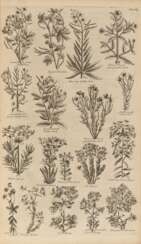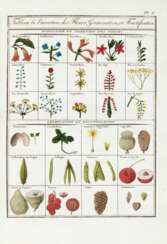4862 Items by auctions and galleries:
plants
Lot 38 Presentation copy of Insectivorous Plants
Charles Robert Darwin (1809 - 1882)  Fine Printed Books and Manuscripts including Americana
Fine Printed Books and Manuscripts including Americana 

Charles Robert Darwin
12.02.1809 - 19.04.1882
United Kingdom
Charles Robert Darwin was an English naturalist, geologist, and biologist, widely known for contributing to the understanding of evolutionary biology. His proposition that all species of life have descended from a common ancestor is now generally accepted and considered a fundamental concept in science. In a joint publication with Alfred Russel Wallace, he introduced his scientific theory that this branching pattern of evolution resulted from a process that he called natural selection, in which the struggle for existence has a similar effect to the artificial selection involved in selective breeding. Darwin has been described as one of the most influential figures in human history, and he was honoured by burial in Westminster Abbey.

CHRISTIE'S
Fine Printed Books and Manuscripts including Americana
Date: 19.10.2023 10:00 UTC -05:00
Number of lots in the catalog: 357
Lot 83 Monandrian Plants of the Order Scimitaneae, Liverpool, [1824-]28, modern green half morocco
William Roscoe (1753 - 1831)  Travel, Atlases, Maps, Photographs & Natural History
Travel, Atlases, Maps, Photographs & Natural History 

William Roscoe
08.03.1753 - 30.06.1831

Sotheby´s
Travel, Atlases, Maps, Photographs & Natural History
Date: 21.09.2023 10:00 UTC +00:00
Number of lots in the catalog: 265
Lot 128 DARWIN, Charles. Interessante lotto dedicato al celebre naturalista che include diversi testi in inglese, francese e italiano fra cui la prima edizione di Insectivorous Plants
A519-I: Books and Manuscripts Auction 

Il Ponte Casa d'Aste
A519-I: Books and Manuscripts Auction
Date: 21.09.2021 10:30 UTC +01:00
Number of lots in the catalog: 182
Lot 59 Plantes de la France, Paris, 1808-1809, 4 volumes, contemporary calf gilt
Jean Henri Jaume Saint-Hilaire (1772 - 1845)  Travel, Atlases, Maps, Photographs & Natural History
Travel, Atlases, Maps, Photographs & Natural History 

Jean Henri Jaume Saint-Hilaire
29.10.1772 - 19.06.1845

Sotheby´s
Travel, Atlases, Maps, Photographs & Natural History
Date: 21.09.2023 10:00 UTC +00:00
Number of lots in the catalog: 265
Lot 87 Robert Warner | Select orchidaceous plants. London, 1862–1875, outstanding botanical lithographs by Fitch
Robert Warner (1814 - 1896)  Benjamin Samuel Williams (1822 - 1890)
Benjamin Samuel Williams (1822 - 1890)  Fine Books from a Distinguished Private Library
Fine Books from a Distinguished Private Library 

Robert Warner
1814 - 1896

Benjamin Samuel Williams
02.03.1822 - 24.06.1890

Sotheby´s
Fine Books from a Distinguished Private Library
Date: 28.11.2023 14:00 UTC +00:00
Number of lots in the catalog: 91
Lot 245 DONATI, Vitaliano (1717-1762) - Essai sur l'histoire naturelle de la Mer Adriatique. Avec une lettre du docteur Leonard Sesler, sur une nouvelle espece de plante terrestre, traduit de l'italien. The Hague: Pierre de Hondt, 1758.
Books and Manuscripts 

Il Ponte Casa d'Aste
Books and Manuscripts
Date: 26.01.2021 15:00 UTC +01:00
Number of lots in the catalog: 131









![Monandrian Plants of the Order Scimitaneae, Liverpool, [1824-]28, modern green half morocco](/assets/image/picture_3102473/2ff18/huhu-acnsj3wkb8rwn3ifrqfy41x9iibh0dfiztwxhihpkpzocprbk5bc1jhdq1694080163jpg__fix_374_244.jpeg)
![Monandrian Plants of the Order Scimitaneae, Liverpool, [1824-]28, modern green half morocco](https://veryimportantlot.com/assets/image/picture_3102473/2ff18/huhu-acnsj3wkb8rwn3ifrqfy41x9iibh0dfiztwxhihpkpzocprbk5bc1jhdq1694080163jpg__fix_374_244.jpeg)









































![[DICTIONNAIRE DES PLANTES ALIMENTAIRES].](/assets/image/picture_2734897/08b3c/7c8d997e47155734efcb61700cbe0c9b1679526000jpg__fix_374_244.jpeg)
![[DICTIONNAIRE DES PLANTES ALIMENTAIRES].](https://veryimportantlot.com/assets/image/picture_2734897/08b3c/7c8d997e47155734efcb61700cbe0c9b1679526000jpg__fix_374_244.jpeg)























